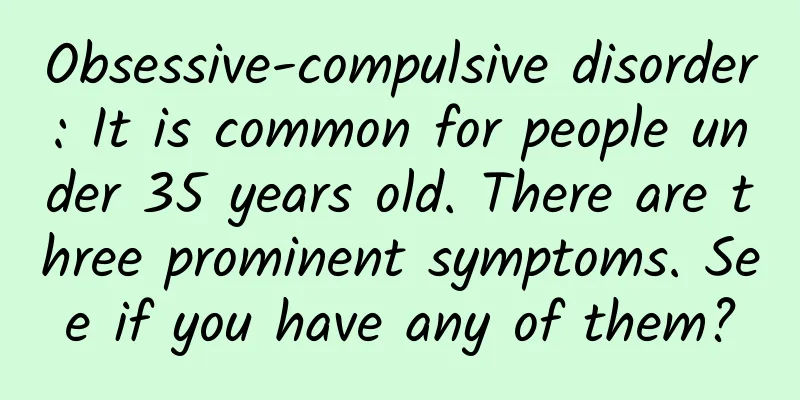Obsessive-compulsive disorder: It is common for people under 35 years old. There are three prominent symptoms. See if you have any of them?

|
Author: Jiang Changqing, Chief Psychologist, Beijing Anding Hospital, Capital Medical University Vice Chairman of the Psychosomatic Medicine Committee of the Chinese Mental Health Association Reviewer: Liu Changwei, Chief Physician, Peking Union Medical College Hospital According to statistics, people aged 19 to 35 are susceptible to obsessive-compulsive disorder, and there is no significant difference in the prevalence rate between men and women. The incidence of obsessive-compulsive disorder is not very high, with only about 1-2 people suffering from it among 100 people. However, my country has a large population base, and there are almost 20 million people suffering from obsessive-compulsive disorder. Obsessive-compulsive disorder is a mild mental disorder. It is a neurotic disorder with obsessive thinking, compulsive behavior, and compulsive intention as prominent symptoms. Its main feature is the coexistence of conscious compulsion and anti-compulsion. 1. What is obsessive thinking? Obsessive thinking, also known as obsessive thoughts, includes obsessive doubt, obsessive thinking, obsessive opposing thinking, and obsessive memories. You always think about things that you think you shouldn’t think about. You can’t stop thinking about them, and you can’t control them. You can’t get rid of them. This creates a conflict and causes great psychological pain. Figure 1 Original copyright image, no permission to reprint Compulsive doubts are common among normal people. For example, when you leave home, you sometimes feel that the door is not locked properly; after sending a letter, you may doubt that the address is not written correctly, the envelope is not sealed properly, or the stamp is not affixed. If you can accept the compulsive doubts, it is fine. If you have to accept them and think about them too much, it will develop in a pathological direction. Compulsive thinking, always asking why when encountering something, and insisting to figure it out, even some objective and truthful things must be figured out, such as why 1+1 equals 2; why people have two eyes instead of four. Normal people generally don't think about these things. Compulsive opposing thinking, when an idea appears in the mind, another idea will appear immediately afterwards, good appears and bad appears, big appears and small appears, tall appears and short appears. Compulsive reminiscence, when it is mild at the beginning, for example, thinking about what you did that day every night; when it becomes serious, in addition to thinking about daily events, at the weekend you will also think about what you did every week, and at the end of the month you will also think about what you did that month. 2. What is compulsive behavior? Compulsive behavior is doing things that you think you shouldn't do. After compulsive behavior occurs, you always want to control it. If you don't do it, you will feel uncomfortable, and if you do it, you will feel very comfortable, so you will repeat this behavior over and over again. The most common compulsive behavior is compulsive checking. For example, after leaving home, if you feel that the door is not locked properly, you go back to check it again. Checking it once is actually normal, and almost everyone may have experienced this situation. Checking it twice is not necessarily abnormal, but checking it more than three times may be abnormal. Figure 2 Original copyright image, no permission to reprint The second is forced counting. Counting the number of electric poles and trees while walking can kill time; counting the number of windows upstairs while waiting for someone can also kill time. This is normal. If you walk from one place to another and feel that you have counted wrong, you have to go back and count again, which is definitely not normal; counting windows while waiting for someone is fine, and you can see if you can walk after the person arrives. It is normal to walk after the person arrives, but it is abnormal if you do not count correctly or cannot walk before counting. The third is compulsive questioning. They always like to ask questions, and they know the answers to the questions they ask. They will ask the same question over and over again. For example, when he goes out, he always thinks that he has lost his wallet. He dares not bring his wallet with him. Even if he goes out without his wallet or money, he still thinks that he has lost money. When he gets home, he asks his family if they have lost money. Later, the symptoms become more generalized. He not only dares not go out, but also dares not bring his wallet with him at home. He thinks that he has lost money. He knows that he has not lost it, but he still asks his family if he has lost it. He feels relieved when others say that he has not lost it. He will ask again after a while if he has lost it. He feels relieved again when others say that he has not lost it. He has to ask many times every day. The fourth is forced washing, including washing hands, taking a bath, and doing clothes. For example, they take longer showers than the average person, from 4pm to 8am the next day. Some people wash their clothes from inside to outside when they get home, no matter how long they are out. They not only wash their own clothes, but also ask their family members to wash their clothes, or help them wash their clothes. They cannot touch their clothes after washing. If they are touched, they have to wash them again, and they use at least one bag of laundry detergent every day. The fifth is compulsive ritual actions. In fact, everyone has some unlucky ideas. For example, people in the north are generally afraid of the number 4, and always think that 4 is unlucky. For example, when choosing a mobile phone number, they would rather choose a number without 4 than spend an extra ten yuan. This is considered normal and has no impact on work, study, and life. If the fear of 4 affects work, study, and life, then you should consider whether you are sick. Clinically, some patients do not take the fourth step when walking, but take 3 steps forward and 1 step back; some patients cannot read pages with 4 in the book, and have to skip the pages with 4. After the symptoms become more generalized, they cannot read multiples of 4. The sixth is compulsive retardation, doing things very slowly. Normal people can be fast or slow, but when they are slow to a certain extent, it is considered pathological. Some patients go to work at 8 am, get up at 6 am, and cannot leave the house until 12 am, which will obviously affect their work; some patients take two hours to take off their down jackets every day, and then take off their pants, outer clothes, and underwear, so they dare not take off their clothes to sleep and sleep in their clothes every day. The more busy a person with obsessive-compulsive retardation is, the slower he moves. When he has nothing to do, he moves faster. When he goes to work, he gets up at 6 a.m. and can't leave the house until 12 p.m. On Sundays, when he doesn't have to work, he can usually leave the house at 8 a.m. The less busy he is and the less urgent he is, the faster he moves. This is fundamentally different from the slow movements of normal people. 3. What is forced intention? Compulsive intention is between thinking and doing, wanting to do something but not doing it. For example, when standing on a tall building, you feel an urge to jump down, but you will never jump; when you go to the kitchen and get a kitchen knife, you have an urge to chop your family members, but you will not do it; when standing by the river, you have the urge to jump into the river, or holding a skewer for lamb, you want to poke someone's eyes, or when standing by the road, you want to crawl under the wheel of a car. You have this urge, but you will not put it into action. Figure 3 Original copyright image, no permission to reprint In fact, normal people also have this kind of impulse. Normal people only have impulse and no avoidance, while patients with obsessive-compulsive disorder have both impulse and avoidance. For example, when standing on a high place, they are afraid of falling down, and they dare not go to a high place again; when holding a kitchen knife, they feel like chopping family members, and they dare not enter the kitchen again. If there is obvious avoidance behavior, it will develop in a pathological direction. The above are the three main symptoms of obsessive-compulsive disorder. If the symptoms of obsessive-compulsive disorder are mild and you have a better understanding of the disease, or read some professional books and make self-adjustments, you can completely return to normal. If the symptoms become serious, you must see a psychiatrist for treatment. |
Recommend
Six factors are associated with breast cancer, and one exercise can keep you away from it
Breast cancer is showing a trend of being diagnos...
Seven months pregnant fetus around the neck
When babies are still in the mother's belly, ...
The reason why the cheeks are red and have small pimples
Female friends all hope to have fair and smooth f...
How many days after miscarriage can you have sex
Now after a miscarriage, you need to pay attentio...
Does leucorrhea inflammation affect pregnancy?
After women have had sex, they are particularly p...
When does a woman stop menstruating?
Women's menstruation follows a certain regula...
Sore arms and legs during early pregnancy
In the early stages of pregnancy, women are very ...
What is the reason for not ovulating?
If you always feel that you cannot ovulate, it is...
Can women do yoga during menstruation?
Women’s menstrual cycle is also known as the “sma...
Why is my period black at the beginning?
Why is the menstrual blood gray and black at the ...
Cardiogenic shock: challenges and miracles of the life pump
Imagine that the human heart is like a tireless p...
What are the methods to treat vulvar leukoplakia?
Leukoplakia of the genitals is a disease that tro...
Sleeping at this time every day can really reduce the risk of cardiovascular disease! Try it now!
Some people say that going to bed early and getti...
The correct way for women to wear underwear
Many women just put on their underwear randomly. ...









